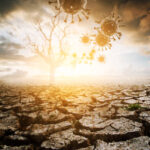Dear Friends,
As we move into April and week six of Russia’s brutal assault on Ukraine, it goes without saying that the invasion is rewriting most of our global rules and calculations. The changes have implications not only for international politics, but also for ideas about energy security and the role of fossil fuels in the short- and long-term future.
It’s a critical inflection point. For the foreseeable future, economies will continue to need fossil fuels, and the U.S., the number one producer of oil and gas, is well positioned to both help fill the gap and benefit from Russia’s fall from grace.
But at the same time, the disruptions from climate change build in intensity and frequency, and the imperative to transition away from fossil fuels strengthens. Time is short. As a U.N. report issued this week so starkly warns, the window to move to a low-carbon economy in time to prevent the worst changes is closing. The report’s tragic irony? We actually have the tools to lower the risk of climate change. We just aren’t transitioning to them quickly enough to stay safe.
We see these themes throughout recent news as world leaders wrestle with their response to the crises and many communities wrestle both with the escalating costs of energy and the physical and economic damage fueled by climate change.
But there is encouraging news. While the energy transition may face headwinds in some countries due to the crises, the commitment to it over the long term remains strong. And Europe is doubling down, planning rapid boosts in renewable energy and more robust measures in energy efficiency. EU policy leaders recognize that cutting demand for fossil fuels is the most important way toward energy independence and national security.
How fast can Europe, and the rest of the world, transition? That, of course, is the question – but it is being answered every day by innovations and initiatives large and small – and now, by the West’s renewed resolve against Putin.
Warmly,
The C-Change Conversations Team
Notable Quote
“We must become independent from Russian oil, coal and gas. We simply cannot rely on a supplier who explicitly threatens us. We need to act now to mitigate the impact of rising energy prices, diversify our gas supply for next winter and accelerate the clean energy transition. The quicker we switch to renewables and hydrogen, combined with more energy efficiency, the quicker we will be truly independent and master our energy system.”
– Ursula von der Leyen, President of the European Commission
News of Concern
Although the war in Ukraine understandably dominated headlines last month, there was another devastating historic moment: global carbon emissions have rebounded from the pandemic pause to reach the highest levels in recorded history. Carbon dioxide, of course, is the greenhouse gas most responsible for global warming.
Also in March, the prestigious science journal Nature published a report that evaluated decades of satellite data collected over the Amazon rainforest – one of the planet’s most important carbon sinks. It concluded that the rainforest is nearing its tipping point. More than half of it could be transformed into savanna within a few decades in a transition that would vastly accelerate the pace of climate change.
As if that news wasn’t bad enough, March saw the first ever collapse of an ice shelf in East Antarctica, the coldest part of the frozen continent. Ice shelves act as ‘bottle stoppers’ containing the flow of ice into the sea, and their destruction would cause sea level rises around the world. Discovery of a large crack in another, more critical ice shelf in West Antarctica suggests it could also disintegrate this decade.
Closer to home, a drier but equally grim byproduct of the warming planet made news in the American Southwest. Arizona’s Lake Powell – the second largest reservoir in the country – dropped to all-time low water levels, threatening the electricity supply for six million people. Scientists say that some 2,300 miles east, climate change will raise New York’s Hudson River as much as four feet over the next six decades, swamping animal habitats, oil terminals, municipal water works and more. And new research published in the Proceedings of the National Academies of Science says that the number of killer ‘smoke waves’ from wildfires will sweep the Pacific Northwest every three to five years by the end of this century. That means, of course, massive, uncontained wildfires will likely become the new normal.
Scientific studies like these repeatedly highlight that there is no place to hide from climate change, and they are critical to our ability to plan for the future. That’s why we are disturbed by another, less predictable bit of fallout from the Ukrainian crisis: its effect on climate science. Russia’s invasion has hampered numerous important research programs, from a massive fusion energy research machine under construction in southern France to an Arctic expedition aimed at permafrost research. It’s another small reason – as if another was needed – that we look forward to the war’s end.
News of Hope
While Russiaenergy exports were not part of economic sanctions that the international community imposed in response to the invasion of Ukraine, we’re encouraged that the European Commission (EC) has just proposed a plan to reduce Europe’s heavy reliance on Russian gas by two-thirds before the end of this year and become completely independent of all Russian fossil fuels ‘well before’ 2030. The EC also declared that the invasion required Europe to ‘drastically accelerate’ its transition to clean energy. More detailed policies are expected from the EC in the coming months but the prospects for Europe accelerating its energy transition are looking stronger and stronger.
The new geopolitical and energy market realities have activated similar calculations among U.S. security experts. Writing in The Hill newspaper, retired Admiral Dennis V. McGinn reminded us that Russia isn’t the first petrostate to weaponize energy and argues that a transition to renewables would ‘remove fossil fuels as a tool for dictators.’
Other positive developments on the international stage also mitigated the March gloom. In a move described as the biggest environmental deal since the 2015 Paris Accord, the United Nations approved the first ever treaty to regulate global plastic pollution. Plastics are predominantly made from petrochemicals, and back in 2019 the impact of global plastic production on climate was calculated to be equivalent to 189 coal-fired power stations. So, yes. This is a big deal.
There’s more optimistic news, coming from Asia. Apparently China’s regional governments laid out plans to add so much energy capacity to their grids from non-fossil fuel sources that China may reach its 2030 renewable energy targets by 2025, despite short-term moves to bolster fossil fuels due to the war in Europe. The world’s largest greenhouse gas emitter is also the largest producer of low-carbon technology. China dominates these emerging fields, historically outspending the U.S. two to one, and is building the world’s largest fleet of renewable generation sources.
And let’s not ignore the many climate initiatives here in the States. In an eye-popping move, the Securities and Exchange Commission (SEC) approved a landmark proposal requiring all public companies to disclose their greenhouse gas emissions and risk profiles for climate change. Although some argue the SEC may be swimming outside its lane, the requirement is yet another reminder to investors and businesses alike that global warming is a threat to profitability and viability.
In the category of small but notable progress, a new electric vehicle (EV) battery plant has been announced for West Virginia, successfully bringing new energy jobs to an area economically harmed by our transition away from coal. We’re also happy to see that Koch Industries has emerged as one of the nation’s biggest investors in the U.S. battery supply chain. This illustrates how the economics around energy are shifting. Koch built its business on fossil fuels and has historically fought climate legislation and funded climate denial, yet now sees great economic opportunities in new non-carbon technologies.
Notable Graph
We’ll end this edition of Curated Climate News as we started. The balance of short-term and long-term priorities are, well, hanging in the balance. Europe and the U.S. have to keep the lights on and homes warm while planning for a fossil-free future. But take a look at this graph. On a cost basis alone, renewables could well win the day.



